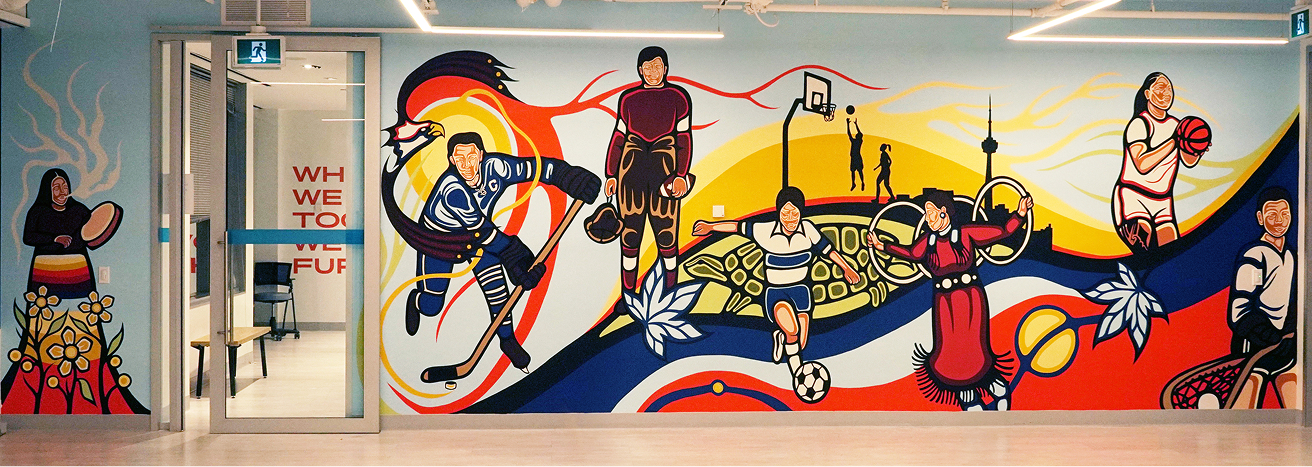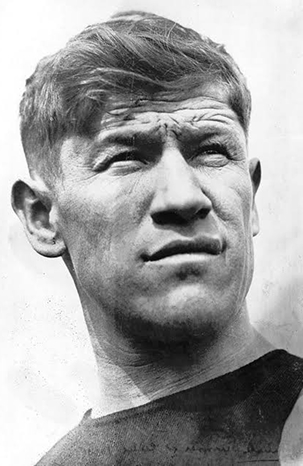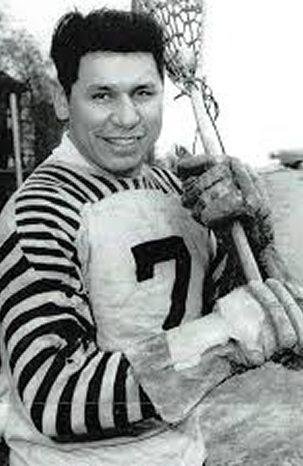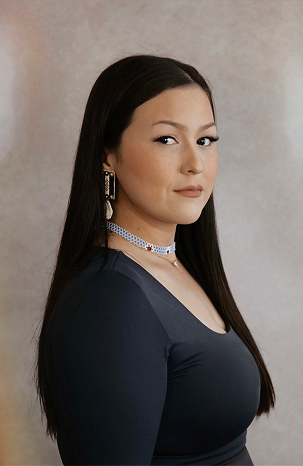




Fawn grew up immersed in the cultural and musical traditions of her parents; her father, Earl Wood, is from Saddle Lake Cree Nation. Her mother, Cindy Jim-Wood, taught her the traditions and Salish chants of the Whonnock and Stl'atl'imx peoples.
Fawn released her debut solo album in 2012 titled Iskwewak – Songs of Indigenous Womanhood. Fawn was named Best Female Artist at the Native American Music Awards the following year. Her music also earned her Best Hand Drum recording at the 2013 Aboriginal Peoples Music Choice Awards. Music has become a powerful tool for her to share in the revitalization of the Cree language, inspiring young Indigenous people to develop their cultural practices and keep languages alive.

One of the first Indigenous hockey players in professional hockey, George Edward Armstrong, was a hockey player, coach, scout who spent his entire 21-season long National Hockey League career with the Toronto Maple Leafs. He was team captain for 12 seasons, the longest reign in the club’s history. He led the Maple Leafs to four Stanley Cup championships. His empty-net goal to clinch the 1967 Stanley Cup was the final goal scored in the Original Six era. Armstrong, who was Algonquin, was one of the most prominent Indigenous athletes of his era. He was inducted into the Hockey Hall of Fame in 1975.

From the Potawatomi, Menominee, and Kickapoo nations, Jim was the USA’s greatest athlete of the 20th century. He was the first Indigenous athlete to win gold in the 1912 Olympics, setting a world record in track and field. He played 6 seasons in major league baseball with the New York Giants, Cincinnati Reds, and Boston Braves. He also played professional American football, and was known to be a NFL pioneer, and 3 times world champion. He helped establish the National Football League with the Canton Bulldogs of Ohio and became its first president in 1920. He was awarded the Medal of Freedom in 2024 for his exceptional athleticism in various sports and his legacy as an Indigenous icon.

Terry Felix of the Sts’ailes First Nation in Agassiz was the first Indigenous professional soccer player in North America and the first Indigenous player on Canada Men's Team in 1983.Terry Felix, a member of the Sts’ailes First Nation (Chehalis) was born in 1959 in Matsqui and raised on the Chehalis Reserve in Agassiz. Reflecting the importance of soccer in many First Nations communities throughout BC, in 13 years Terry played in over 120 First Nations Soccer Tournaments with Sasquatch FC and Musqueam Blues soccer teams.
Terry was spotted by a Whitecaps scout in 1980 and joined the club’s youth team, which is where he had his first formal structured soccer practice. In 1981 he signed amateur papers with the club and won the Pacific North West League with the Whitecaps Reserves in 1982. In September 1982 Felix accepted a professional contract, playing eight games for the Whitecaps in 1983. This made Terry Felix the first First Nations player to play professional soccer in North America. One of Terry’s stand-out moments was against the New York Cosmos, his first NASL game, when he earned an assist by setting up the Whitecaps first goal in a 2-0 victory in front of over 50,000 fans in the new BC Place. A second memory was scoring his first goal as the Whitecaps defeated Team America 2-0 in Washington DC.
Felix was selected for five Canadian national teams in 1983. First he played two games in May for Canada's Olympic qualifying team against Bermuda, scoring two goals in his first game. In June he gained his three caps in international "A" games in friendly games against Scotland. In October 1983, Terry was training with the Olympic team in Victoria when he suffered a career-ending knee injury
Since his playing days, Terry has coached many First Nation soccer teams, including winning the 1992 BC First Nations provincial championship, taught numerous First Nations soccer clinics and arranged the Sts’ailes First Nation youth tournament. In 2016, he assisted his son Peter Felix who coached the BC Under 18 Girls team to the 2016 North American Indigenous Games Gold Medal. Friend Georgina Paul writes: “He is an inspiration to First Nations players in BC and is a strong advocate for the sport”.
Terry Felix was inducted into the Soccer Hall of Fame of BC in 2020 and was inducted into the North American Indigenous Athletics Hall of Fame in 2024.

Lisa is the first woman to win World Champion Hoop Dancer at the prestigious Annual Heard Museum World Championship Hoop Dance Contest in Phoenix, Arizona. She is a Two Time World Champion Hoop Dancer, along with six additional hoop dance championship titles won throughout Canada and United States in the Adult 18+ category. Lisa recently won 2 nd place at the 30th Annual Heard Museum World Championship Hoop Dance Contest in Phoenix, Arizona (February 9, 2020)–just missing out on 2020 World Champion title by-ONE point. There, Lisa was featured in VOGUE-February 2020.
Lisa has performed throughout Canada, the United States, and overseas including, Italy, France, Holland, Germany, Korea, Mexico, Israel, Palestine & Jamaica to name a few. Lisa is a former member of the North American Indian Dance Theatre. She performed at the Winter Olympic Games Closing Ceremony in Salt Lake City, Utah, the Pan American Games Closing and Opening Ceremonies for the Para Pan American Games in Toronto, Ontario. Lisa was the featured hoop dancer at the Calgary Stampede Grandstand show- five times.
She performs periodically with A Tribe Called Red and is the current Wiikwemkoong Iron Woman Fancy Dance champion, Adults 18+ category (winning years 2018 & 2019). Lisa performed for Queen Elizabeth II and was the invited hoop dancer to take part in the United Nations, Meeting of the Parties Global Climate Change Summit in Montreal, QC hosted by Environment Canada. Lisa is the featured hoop dancer in the ELLE video called the Movement, filmed in New York City.

Alissa Pili is a WNBA player with Inupiaq and Samoan ancestry. She is a role model and advocate for both Indigenous and Samoan communities and regularly participates in charitable activities and cultural events representing both of her heritage. Pili utilizes her influence to honour and preserve cultures while promoting the development and progress of Indigenous and Samoan communities. Alissa Katelina Pili's influence and contributions extend beyond the realm of sports into other aspects of life and culture, making her a multimedia icon and a positive role model for future generations.

Gaylord Powless, lacrosse player (born 1 December 1946 in Six Nations of the Grand River, ON; died 28 July 2001 in Ohsweken, ON). Gaylord Powless was a Kanyen’kehà:ka (Mohawk) box lacrosse player who transcended the game to become one of Canada’s most famous athletes. Powless lived most of his life in Six Nations of the Grand River, near Brantford, Ontario. He became the signature player on the Oshawa Green Gaels’ junior lacrosse dynasty of the 1960s and shattered the Ontario junior league scoring record in his sophomore year with the team. The Gaels won the Minto Cup, Canada’s national junior lacrosse championship, in all four years that he played at the junior level. Powless also won the 1971 Mann Cup, which is emblematic of the Canadian senior lacrosse champions, and was a marquee player in three different professional leagues. Powless and his father, Ross, are both members of the Canadian Lacrosse Hall of Fame and the Ontario Lacrosse Hall of Fame. In 2017, Powless was elected to Canada’s Sports Hall of Fame. In 2024, Powless was inducted into the North American Indigenous Athletics Hall of Fame.
was a Haudenosaunee lacrosse player from Six Nations who was awarded the Tom Longboat award at 17 years of age which recognized him as the best Indigenous athlete in Canada. He was inducted into Canada’s Sports Hall of Fame in 2017, as well as the Order of Sport, and the North American Indigenous Athletics Hall of Fame for his lasting impact on the sport and the Indigenous sports community

One of the first Indigenous hockey players in professional hockey, George Edward Armstrong, was a hockey player, coach, scout who spent his entire 21-season long National Hockey League career with the Toronto Maple Leafs. He was team captain for 12 seasons, the longest reign in the club’s history. He led the Maple Leafs to four Stanley Cup championships. His empty-net goal to clinch the 1967 Stanley Cup was the final goal scored in the Original Six era. Armstrong, who was Algonquin, was one of the most prominent Indigenous athletes of his era. He was inducted into the Hockey Hall of Fame in 1975.

From the Potawatomi, Menominee, and Kickapoo nations, Jim was the USA’s greatest athlete of the 20th century. He was the first Indigenous athlete to win gold in the 1912 Olympics, setting a world record in track and field. He played 6 seasons in major league baseball with the New York Giants, Cincinnati Reds, and Boston Braves. He also played professional American football, and was known to be a NFL pioneer, and 3 times world champion. He helped establish the National Football League with the Canton Bulldogs of Ohio and became its first president in 1920. He was awarded the Medal of Freedom in 2024 for his exceptional athleticism in various sports and his legacy as an Indigenous icon.

Terry Felix of the Sts’ailes First Nation in Agassiz was the first Indigenous professional soccer player in North America and the first Indigenous player on Canada Men's Team in 1983.Terry Felix, a member of the Sts’ailes First Nation (Chehalis) was born in 1959 in Matsqui and raised on the Chehalis Reserve in Agassiz. Reflecting the importance of soccer in many First Nations communities throughout BC, in 13 years Terry played in over 120 First Nations Soccer Tournaments with Sasquatch FC and Musqueam Blues soccer teams.
Terry was spotted by a Whitecaps scout in 1980 and joined the club’s youth team, which is where he had his first formal structured soccer practice. In 1981 he signed amateur papers with the club and won the Pacific North West League with the Whitecaps Reserves in 1982. In September 1982 Felix accepted a professional contract, playing eight games for the Whitecaps in 1983. This made Terry Felix the first First Nations player to play professional soccer in North America. One of Terry’s stand-out moments was against the New York Cosmos, his first NASL game, when he earned an assist by setting up the Whitecaps first goal in a 2-0 victory in front of over 50,000 fans in the new BC Place. A second memory was scoring his first goal as the Whitecaps defeated Team America 2-0 in Washington DC.
Felix was selected for five Canadian national teams in 1983. First he played two games in May for Canada's Olympic qualifying team against Bermuda, scoring two goals in his first game. In June he gained his three caps in international "A" games in friendly games against Scotland. In October 1983, Terry was training with the Olympic team in Victoria when he suffered a career-ending knee injury
Since his playing days, Terry has coached many First Nation soccer teams, including winning the 1992 BC First Nations provincial championship, taught numerous First Nations soccer clinics and arranged the Sts’ailes First Nation youth tournament. In 2016, he assisted his son Peter Felix who coached the BC Under 18 Girls team to the 2016 North American Indigenous Games Gold Medal. Friend Georgina Paul writes: “He is an inspiration to First Nations players in BC and is a strong advocate for the sport”.
Terry Felix was inducted into the Soccer Hall of Fame of BC in 2020 and was inducted into the North American Indigenous Athletics Hall of Fame in 2024.

Lisa is the first woman to win World Champion Hoop Dancer at the prestigious Annual Heard Museum World Championship Hoop Dance Contest in Phoenix, Arizona. She is a Two Time World Champion Hoop Dancer, along with six additional hoop dance championship titles won throughout Canada and United States in the Adult 18+ category. Lisa recently won 2 nd place at the 30th Annual Heard Museum World Championship Hoop Dance Contest in Phoenix, Arizona (February 9, 2020)–just missing out on 2020 World Champion title by-ONE point. There, Lisa was featured in VOGUE-February 2020.
Lisa has performed throughout Canada, the United States, and overseas including, Italy, France, Holland, Germany, Korea, Mexico, Israel, Palestine & Jamaica to name a few. Lisa is a former member of the North American Indian Dance Theatre. She performed at the Winter Olympic Games Closing Ceremony in Salt Lake City, Utah, the Pan American Games Closing and Opening Ceremonies for the Para Pan American Games in Toronto, Ontario. Lisa was the featured hoop dancer at the Calgary Stampede Grandstand show- five times.
She performs periodically with A Tribe Called Red and is the current Wiikwemkoong Iron Woman Fancy Dance champion, Adults 18+ category (winning years 2018 & 2019). Lisa performed for Queen Elizabeth II and was the invited hoop dancer to take part in the United Nations, Meeting of the Parties Global Climate Change Summit in Montreal, QC hosted by Environment Canada. Lisa is the featured hoop dancer in the ELLE video called the Movement, filmed in New York City.


Emily Kewageshig is an Anishinaabe artist and visual storyteller from Saugeen First Nation No. 29. With a deep-rooted connection to her heritage, her artwork explores the intricate interconnection of life forms, weaving together both traditional and contemporary materials.
Her creative practice is centered around the cyclical themes of birth, death, and rebirth - concepts that have profound significance in both her cultural teachings and personal lived experiences.
In 2020, Emily celebrated her first solo exhibition titled "Mooshknemgog Bmaadziwin: Full Circle," showcased at the Tom Thomson Art Gallery in Owen Sound, Ontario. This milestone marked a significant moment in her career, highlighting the intersection of her artistic expression with her Indigenous roots. Emily continues to produce artwork for a wide array of organizations, using her art as a tool to elevate and honour Indigenous knowledge, culture, and identity.
Emily's journey as an artist is one of resilience and determination. Leaving her home reserve at the age of 17, she moved to Toronto with aspirations of pursuing higher education and making a living through her passion for creating art. After graduating with Honours from Sheridan College’s Visual and Creative Arts Diploma program in 2017, where she was awarded “Best in Show” at the final graduate exhibition. Emily continued her studies at OCAD University in the BFA Indigenous Visual Culture program (2017-2020). Her experiences as a mother, especially after becoming a parent in 2018, inspired her to reflect on the cyclical nature of life - a concept deeply rooted in her Anishinaabe worldview. She believes that life is a never-ending circle, where everything is interconnected and flows with balance and harmony.
As an artist, Emily's work draws on vivid colours, bold graphic lines, and a combination of traditional and contemporary materials. Each piece captures the delicate balance between culture, identity, and the cycles of life, illustrating how each plant, animal, and person plays an essential role in the sustainability of our ecosystems for future generations.
Emily is not only an artist but also a role model and advocate for Indigenous youth across Turtle Island. Through her work, she continues to inspire and educate, fostering a deeper understanding of Indigenous perspectives. Her commitment to her craft and cultural heritage has led her to collaborate with renowned organizations and brands, including CBC, DavidsTea, Manitobah Mukluks, Globe and Mail, Toronto Argonauts, Redken, Purolator, Parks Canada, NBC Universal, and MiniTipi. Her work has been highlighted nationally by APTN and CBC news.
She is also the illustrator of three notable books: Walking Together, With Our Orange Hearts, and Of the Sun. Additionally, Emily has created many murals across Toronto, Ontario, infusing public spaces with Indigenous art that serves as a visual celebration of her culture and teachings.
As an Artist Ambassador with the Gord Downie & Chanie Wenjack Foundation, Emily uses her platform to raise awareness and encourage reconciliation between Indigenous and non-Indigenous communities. She was featured in a short film by National Geographic titled Flowing through Ontario’s Many Wonders of Water, where she highlighted the importance of preserving water sources and championing Indigenous rights as an advocate for environmental sustainability.
Through her work, Emily continues to connect past, present, and future, ensuring that the knowledge and beauty of Indigenous cultures remain vibrant and resilient for generations to come. sponding to the Truth and Reconciliation Commissions’s 94 Calls to Action.